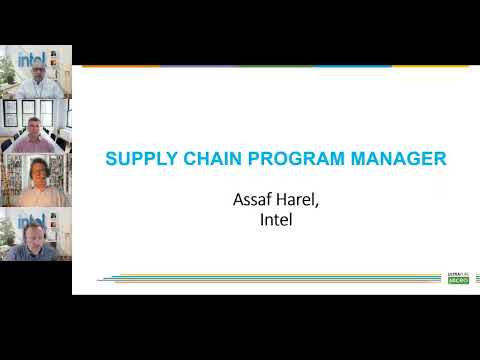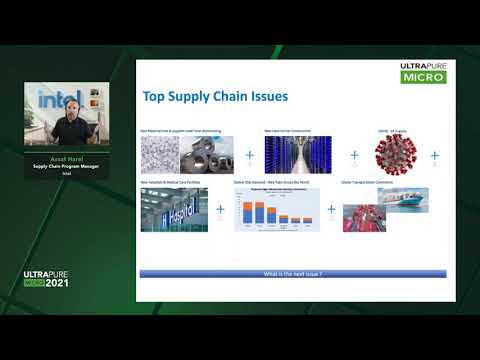
Orla McCoy
Global Water Intelligence
Collaborators
Tags
Supply ChainConstructionTalent ShortageDigital transformationFive potential solutions for time-to-market and supply chain pressures: UPM Community Event recap
A UPM recap of the event Deconstructing the Challenges of Facility 2.0: Time-to-Market and Supply Chain in the semiconductor industry
Share this insight
View the event recording here. Panelists include Assaf Harel, Intel, James Casey, LotusWorks, Alan Knapp, Evoqua, and Dave Buesser, FTD Solutions. The discussion was moderated by Alex Milshteen, Intel.
Facilities are becoming more complex to meet the demands of the next generations of devices. The Community Event Deconstructing the Challenges of Facility 2.0: Time-to-market and Supply Chain highlighted some solutions to what Alex Milshteen, Global Engineering and Commissioning Manager at Intel, calls the ‘perfect storm’. To meet chip demand, manufacturers are constructing more of these highly complex fabs. New factories are being strung together to form mega campuses meaning that bringing a fab online according to schedule is challenging, as facilities must be interconnected with the rest of the campus. At the same time, lead times are unprecedentedly long, supply chain issues are disrupting schedules, and shortages of trained staff affect the construction and operating of new facilities.
The charts below exemplify the problem. Several vital parts for semiconductor manufacturing have a much longer actual lead time in comparison to the contracted time for delivery. Solutions for ramping up chip demand, such as increasing factory utilization, expanding fab capacity, or starting greenfield projects, all have long lead times.
The UPM Community Event highlighted five potential areas to look for solutions:
1. The digital transformation will be critical to accelerating time-to-market The digital transformation and information systems are key to resolving supply chain bottlenecks. Digital systems enable data-driven decision-making about project construction, commissioning and procurement of equipment or material. The industry should strive to generate data-based models to serve as the basis for multiple projects and to facilitate communication across the supply chain. For example, digital models can provide analytics which will diagnose and respond to issues in the supply chain, or help to communicate the basis of design to suppliers or service providers to accelerate start up.
2. Innovations in construction approach provide opportunities to ease supply chain pressures Modular design; premanufacture; off-site manufacturing, commissioning and quality assurance and quality control can reduce installation and commissioning times by reducing the number of components that the end-user must source. Additionally, solutions involving non-recurring engineering should be avoided as much as possible to reduce time spent on engineering during project start-up.
3. Temporary solutions can reduce overall start-up time
Temporary workarounds can be employed during start-up and commissioning phases to accelerate the commencement of operations. During the UPM event, Alan Knapp, Senior Director for Microelectronics at Evoqua, illustrated how this concept can be applied to water systems. Used ultrapure water (UPW) is typically be reused for cooling water, process loops, rinsing and other auxiliary applications. However, as commissioning times for full-scale UPW systems are lengthy, fabs can temporarily rely on systems that generate water of a high quality, though not as pure as UPW.
4. Industry collaboration is vital for new procurement practices Supply chain pressures have forced changes in procurement practices. Projects must now procure equipment and materials in advance or during the design phase, meaning stakeholders must continually align on needs and specifications as the fab design develops. Different stakeholder must also now be engaged earlier in the project development process. For example, installation teams should become involved in the early engineering stage to ensure their familiarization with the equipment that will eventually be installed.
5. Training programs must be accelerated
Many of the experts that had been involved in fab construction and start-up left the industry years ago during the greenfield project slowdown. With the industry now entering a new period of growth and construction, knowledge-sharing and training is important to ensure those involved in start-up and commissioning are adequately prepared.
Share this insight
Related insights
Digital transformation: opportunities and challenges for the semiconductor industry

Georgia Bottomley
Global Water Intelligence
What are the benefits of collaborative delivery models for wastewater treatment plants?

Vince Como
Kiewit
News-in-brief: June 2023

Orla McCoy
Global Water Intelligence
Related resources

Deconstructing the Challenges of Facility 2.0.: Time-to-market and Supply Chain in the Microelectronics Industry

Enabling Time-To-Market for Next Generation Semiconductor Facilities
Time To Market for Commissioning
